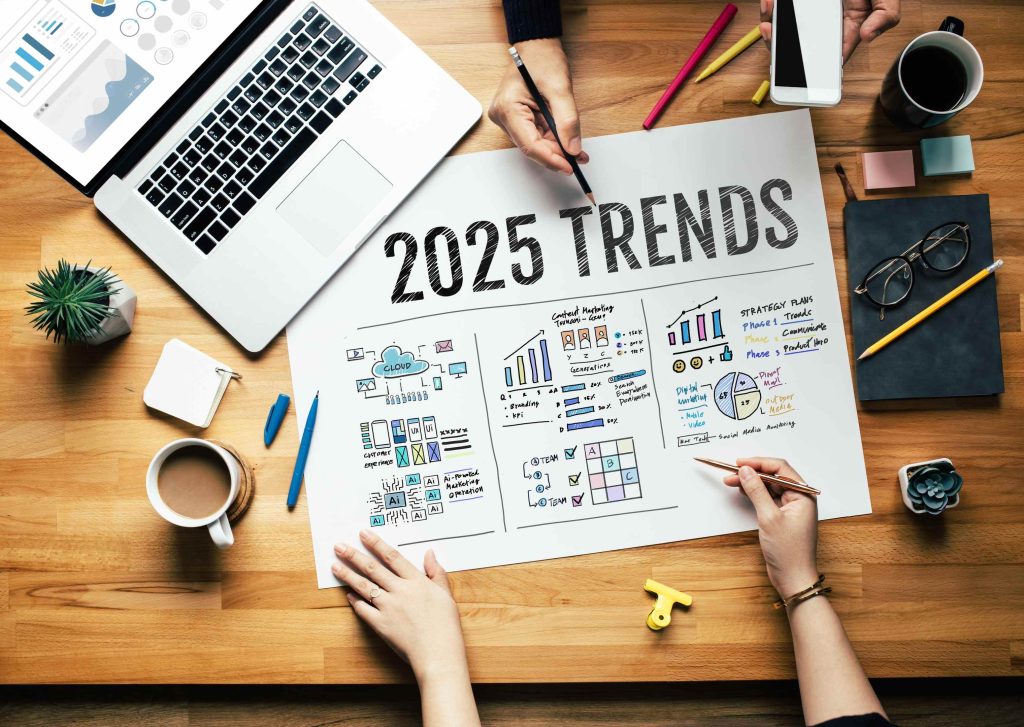Marketing isn’t for the faint-hearted. At its core, it’s about understanding human psychology, and let’s face it, people can be wildly unpredictable. One minute, everyone’s raving ‘I can’t cook at 4am for my husband’, and the next, they’re deep in their Nara Smith making-food-from-scratch era. As marketers, we have to listen, adapt, and occasionally cry in the shower while trying to keep up with trends and what shapes them.
The truth is, humans evolve every day, and with them, the way we connect and communicate has to evolve too. Marketing, at its heart, is about understanding emotions and needs, and using that understanding to inspire action.
So, what are the big trends reshaping how we connect with audiences in 2025? We’ve done the work, and here’s what you need to know.

1. Personalization: It’s No Longer a Luxury, It’s Expected
Now, be honest, how many times have you completely skipped over a “Dear Valued Customer” email? Or even the slightly better “Dear (Your Name)” version? Yeah, same here. Here’s the thing: people don’t just want to feel noticed, they want to feel understood. It’s not enough to say their name; they need to feel like the message was crafted just for them.
Personalisation isn’t a bonus anymore; it’s an expectation. In fact, Acxiom’s annual CX trends report revealed that 51% of customers actually prefer when companies recommend products or services tailored to their unique preferences. Translation? The “basic” strategy just won’t cut it.
And thanks to AI, brands can now take personalization to a whole new level. There are tools out there that don’t just meet your customers’ needs, they anticipate them. Think about that for a second: you’re not just reacting to what people want; you’re predicting it before they even ask. That’s the kind of experience customers are starting to expect.
Takeaway: If you want to stand out, show your audience you see them. Whether it’s through personalized ads or products that feel like they were made just for them, it’s all about that tailored touch.

2. Community Building: Because No One Likes Feeling Lonely
Here’s a fun fact: loneliness is as harmful as smoking 15 cigarettes a day. Yep, you read that right. The U.S. Surgeon General said it, and it’s something brands can’t ignore.
People crave connection, and this is where brands can step in, not to exploit loneliness but to create meaningful spaces where people feel safe and valued. It’s about offering something more than just a product; it’s about fostering a sense of belonging.
Nthabi Motsoeneng, CMO of Pernod Ricard, nails it: “If the passion point is around community collectibles, we can engage with that community using rare, unique, collectible versions of what we have to offer.” It’s about being part of the conversation, not just selling into it.
Takeaway: Want to be the brand people love? Build communities where your audience feels heard, seen, and valued.

3. Artificial Intelligence: The Double-Edged Sword
AI is everywhere, from creating content to tracking audiences, and it’s only going to grow. Did you know that 75% of marketers agree AI will play a bigger role in content creation within the next year? 63% of marketers agree that AI will play a role in audience tracking. But here’s the thing, AI isn’t exactly energy-efficient.
One ChatGPT request uses 10x more energy than a Google search, and AI-generated campaigns can produce emissions equivalent to what seven people generate annually. That’s a lot.
So, the big question: can we balance AI’s incredible potential with sustainability goals? The answer is yes, but it requires leadership that prioritizes both growth and the planet.
Takeaway: AI is powerful, but brands need to think long-term. How can you use AI responsibly while staying innovative and sustainable?

4. Augmented Reality, Virtual Reality, and CGI: The Future Is Now
Be honest, how many times have you seen a hyper-realistic ad and thought, “Is this even real?” Spoiler alert: it’s probably CGI (Computer Generated Imagery).
CGI, AR, and VR are no longer just gaming terms, they’re now essential marketing tools. Brands like Maggi and Maltina have already embraced this trend to create engaging, memorable campaigns. And it’s only going to grow.
Imagine trying on clothes virtually, exploring makeup looks without lifting a brush, or seeing a CGI ad so realistic it gives you goosebumps. That’s the future.
Takeaway: Early adoption of these technologies can set brands apart. If you’re in fashion, beauty, or retail, now’s the time to explore these tools.
Marketing trends are like waves, you either ride them or get swept away. The brands that thrive aren’t necessarily the biggest or the loudest, they’re the ones that adapt quickly and plan smartly.
So, here’s the real question: which of these trends will you embrace, and how will you make it work for your brand?
1. The Rise of AI-Powered Personalization: From Dream to Reality
The era of one-size-fits-all marketing is decisively over. According to McKinsey’s latest digital marketing report, companies that excel at personalization generate 40% more revenue from these activities than average players. Leading brands are leveraging AI to create hyper-personalized experiences at scale.
Gartner’s research reveals that 63% of digital marketing leaders are already using AI/ML for personalization, with implementation expected to accelerate. The technology is moving beyond basic demographic targeting to predictive analytics that anticipate customer needs before they arise.
2. Privacy-First Marketing
The end of third-party cookies might feel like a headache, but it’s actually a blessing in disguise. It’s forcing us to connect with customers more authentically. Deloitte says 75% of companies are prioritizing first-party data, and that shift is creating stronger, more genuine relationships.
3. Social Commerce:
The integration of shopping features into social media platforms continues to accelerate. According to Accenture, global social commerce sales are projected to reach $1.2 trillion, growing at three times the rate of traditional e-commerce. This tells a story of how we’re turning casual scrolling into meaningful transactions and sales.
4. Sustainability: Marketing with Heart and Purpose
This isn’t just another trend. When Harvard Business Review tells us that 73% of millennials will pay more for sustainable brands, they’re revealing something profound: our audience isn’t just buying products; they’re investing in a better future. According to 2023 Edelman Trust Barometer, people are more likely to buy from brands that commit to solving an issue, from improving healthcare access to to addressing climate change to promoting gender equality.
Strategic Implications
- Data Infrastructure Investment The ability to collect, analyze, and activate first-party data will become a critical differentiator. Marketing leaders should prioritize building robust data infrastructure and analytics capabilities.
- Skill Development CMOs must ensure their teams develop new competencies in: • AI and machine learning applications. • Privacy-preserving marketing techniques. • Immersive technology and metaverse platforms. • Sustainable marketing practices.
- Measurement Evolution Traditional marketing metrics are being supplemented with new KPIs that reflect changing priorities: • Customer lifetime value. • Brand purpose alignment. • Privacy compliance metrics. • Sustainability impact measures.
Looking Ahead
The marketing function is evolving from a cost center to a strategic driver of business value. Success will require marketing leaders to balance innovation with pragmatism, experimentation with measurement, and creativity with compliance.
Organizations that invest in understanding and adapting to these trends while building the necessary capabilities will be best positioned to thrive in the evolving marketing landscape.
The question isn’t whether these changes will happen; it’s whether you’ll be leading them or following.

